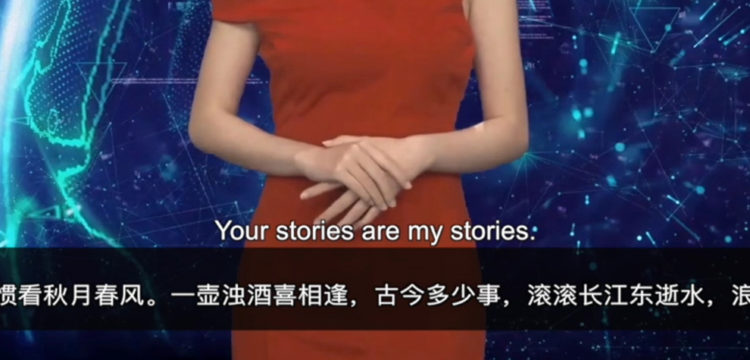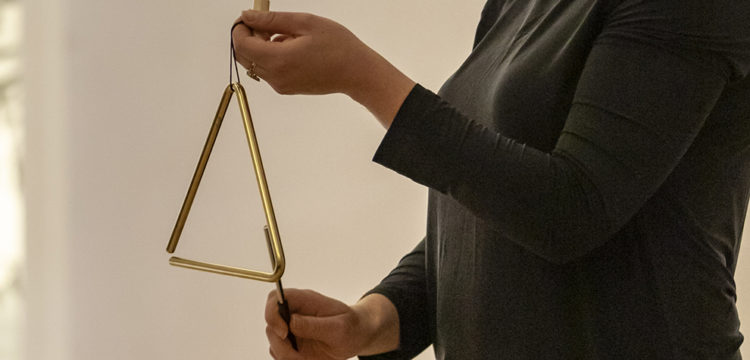Perpetual Present Tense
Nora Turato: the end of the world seems near (but not near enough)
Nora Turato’s performing impact is unrestrained: illuminating, frustrating, at times absurd, though mostly loud and overwhelming. All of which is proudly intentional and proves her point: we find ourselves in the midst of the systemic collapse of late capitalism’s promises, on an appropriately grand scale, with an appropriately panicked tone. Turato’s institutionalism and mercantile sexiness of performance might warrant suspicion, inasmuch as the romanticized contemporary emphasis on transience and presence. In her body and its savvier guises, performance would ideally have to account for a perpetual archive of contemporary resistance, while exploring the formal qualities of the genre’s unique temporality and affect. It would dislodge the sacredness of experience as such, and instead intertwine itself with few media that comprise visual culture today. Her performances could operate in perpetuity, acting a transubstantiation of meanings. Her language presents a cynical capitalization on performance art’s attractive effects and cachet but also a broader humanist codification: consumer technology guarantees the perpetual documentation of the present tense.
In the large Palazzo Moroni’s dining room—also a ballroom in the nineteenth century—Nora Turato’s statements broke through the fragility of the walls’ delicate Venetian plasterwork , the frescoes rendered in delicate colors and the Trompe-l’œil scenario, haranguing while mirroring herself through the eyes of her spectators. While she performed, more colors and imaginary characters were constructing a classical world around her, in the illusion of an exotic landscape.
Ginevra Bria: How did you find your way to art through punk music and graphic design and when did your voice become a clear instrument of our emptiness?
Nora Turato: Is there an anecdote about your voice, triggering and shivering for the first time your body? I started making music when I was 15. It was a lonely-woman thing, bass guitar, recorder, drum machine and me. It was the first time I found something smart to do. I was a very frustrated teenager. When I was 18, it was time to make a decision and possibly enroll in some studies, and I guess graphic design seemed like a great occupation to supplement my music with, both in terms of financial survival and in terms of all the promo stuff surrounding my music I believed I could create. Sometime during my studies, I kind of stopped making music and got very, very passionate about design. During this time, I both worked in the field and did my MA program. I continued to write lyrics but never got to make any song. This is how this whole performance practice of mine was born; I guess I simply realized I was making music in order to have an excuse to write, talk, sing, use my voice. In that moment I realized that maybe I didn’t even need music, things were very clear.
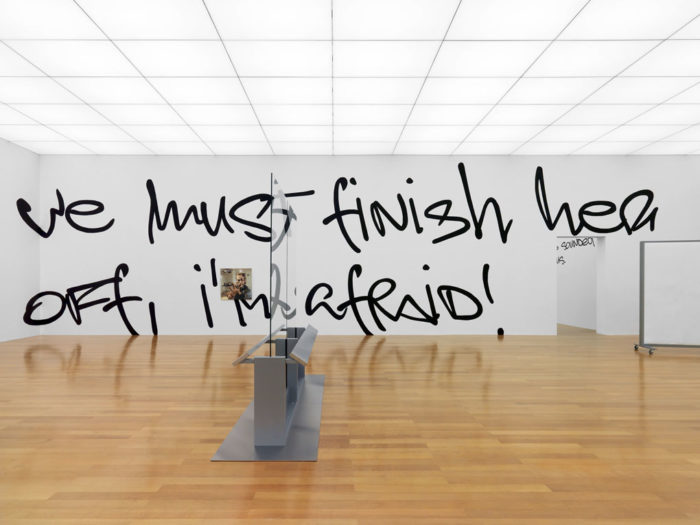
Exhibition view, Nora Turato, explained away at Kunstmuseum Liechtenstein, Vaduz, 2019. Photo Stefan Altenburger Photography, Zürich. Courtesy Kunstmuseum Liechtenstein and Nora Turato.
You once stated “I’m doing this (the artist) by accident because the art world was the first world that let me do this.” Which performance, which artwork could be considered a sort of a turning point into your artistic career and your self-awareness, could you please express why?
I graduated from my bachelor in graphic design with a video that had my voice over and simple typography subtitling it word by word. The video generated some attention and an acquaintance asked me to perform it live and I just said ok. From there on, everything went so organic: from that point on in my life, each single experience blew my mind.
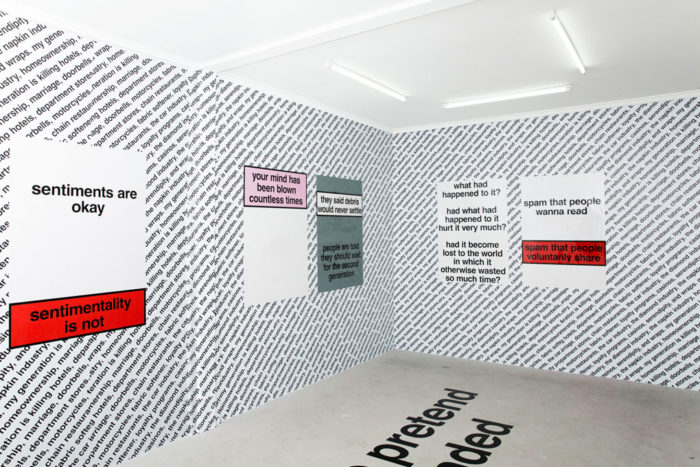
Nora Turato, A Festival of Consent, LambdaLambdaLambda, Prishtina, 2018. Photo Lule Bagta. Courtesy of the artist and LambdaLambdaLambda.
Again, you said “there’s something about living in the West and having a distance from it. But I also have distance from back home. I am always somewhere in between.” How did the use of English changed your access to the new world you were expected to live (Amsterdam, for instance) and enhanced clearly the distance between a language and its meaning?
There is definitely certain degree of abstraction in my work strongly enabled by me not being a native English speaker—there is a certain level of casualness and carelessness. I live in Amsterdam but do not speak Dutch, my mother language is Croatian but do not use that often. I must say I’d rather enjoy living in this English bubble, where we are all using it to get by as best as we can but none of us makes too much out of it.
In the #metoo era where hysteria is stereotyped, how does a performance such as the good, the bad and the viscose (2019) could make women’s body talking over marketing rules and man’s gazes?
The topic of female voice and female hysteria is just one of the few topics weaving through my work, but the press so far has tried to accentuate this aspect. In the light of the moment we live in, this makes total sense, and that’s fine by me since I do think it’s an important topic to discuss and digest collectively. I was born into family of strong men, and women whose lives were rearranged according to what man needed, in a culture that perpetuates this hierarchy and guess I’m reacting consequently. My Dalmatian grandfather told me once no one would have ever married me because I’m too much, and that he could have already foreseen what crazy spinster I would have become if I wouldn’t watch out. I’m so sad he is not alive to see me making a living by being too much professionally.
If your voice would have a body, a solid shape, directly interrelated with your flesh and bones, which would it be?
I would make a great nutribullet! Loud, smashing and blending ingredients… a very contemporary item.
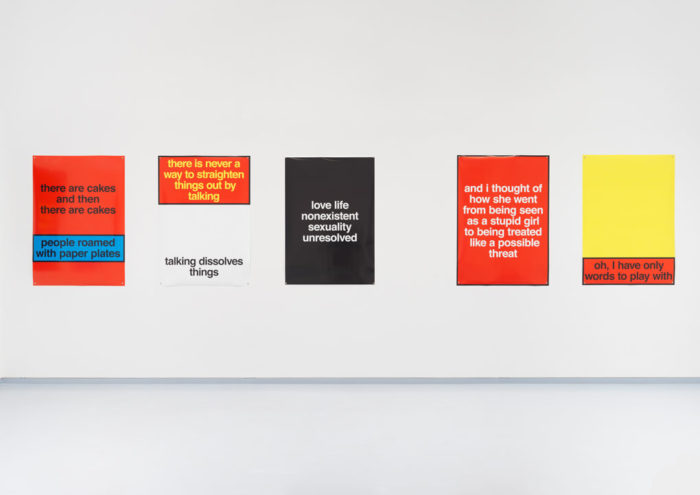
Nora Turato, LambdaLambdaLambda at Metro Pictures, Condo New York, 2018. Photocredit Object Studies. Courtesy the artist and LambdaLambdaLambda.
Performances, artist’s books, silk scarves, wallpapers, and printed posters: how do they convey language in projects such as pool #3 (has anyone tried unplugging it and plugging it back in?), 2019?
I keep a text file open on my phone all the time. I really seek language out constantly, it’s truly what I do most of my time: listen, read, talk and write down everything. A random conversation with a friend can easily result in me writing down a sentence and later sourcing it as a part of my script. Twitter feed, news, movies, literature, vlogs, blogs, reddit, nights out, everything goes and everything can potentially echo back into my scripts. In a weird way, that’s also the true beauty of it all. That living, consuming and digesting culture around me self-generate my work.
I used to work as a graphic designer, I’m also (over)-educated in it. Design is a big part of my life and that naturally keeps reflecting onto my artistic practice. I often work and collaborate with Sabo Day, whom I met during my time at the Rietveld academy. You could argue that my graphic, video and sculptural output is some sort of by-product of my performance practice, a constellation of self-standing elements revolving around my performances, elements that would probably not come into existence without a performance yet are nonetheless able to stand on their own. There are often attempts at encapsulating, documenting and promoting the performance or attempts at expanding and pushing forward the choreography of the performance and potentially its afterlife. Most of it exists somewhere between being kunst and goods, a position I find particularly intriguing. How long before it is considered kunst? How serious do we have to get before we call it art? Digital print on paper is really interesting in that respect. A poster can be printed, ruined and re-printed, fucked up misprints might hang in my friend’s toilet, while the original in its perfection might hang in an exhibition space. There is so much at stake here. But so much comes down to the appeal and projection of effortlessness, that’s remarkably important to me, especially nowadays it’s so easy to go online and find out how a serious work of art should look like, how to produce it, how to document and disseminate it.
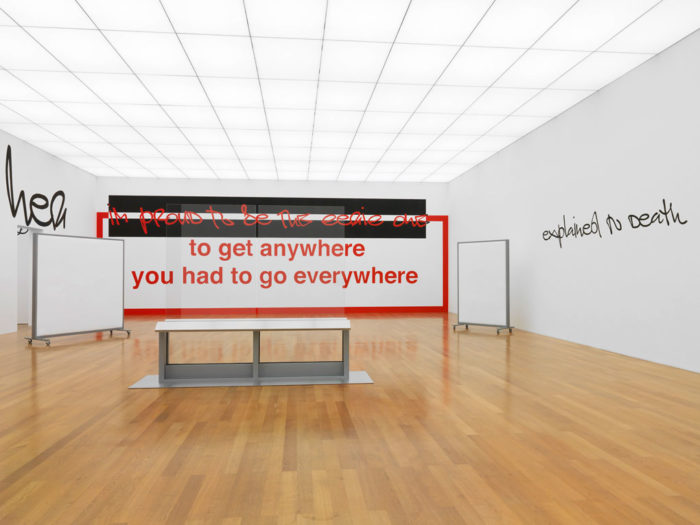
Exhibition view, Nora Turato explained away at Kunstmuseum Liechtenstein, Vaduz, 2019. Photo Stefan Altenburger Photography, Zürich. Courtesy Kunstmuseum Liechtenstein and Nora Turato.
Kunstmuseum Liechtenstein in Vaduz (Explained Away) and at Beursschouwburg in Brussels (Diffusion Line) paved your way to install in public spaces, as a new Concrete Poetry manifesto. How did you approach these projects?
I always source the titles from the script itself, same as I source sentences from other sources for scripts. In the way it’s all circular, recycling language for different contexts and purposes. One sentence abstracted from the context and placed as a title can become quite loaded and I guess this is what I find fascinating. The title Leaning Is the New Sitting comes from an article I’ve read on how the so called “evil designs” are taking over public space and cities, in an attempt to reconcile the need of the elderly to sit down and wait for the bus and having to somehow avoid homeless sleeping on those same benches resulted in some rather fascinating designs for leaning benches. This paradox of having to come up with something restrictive and ending up with an interesting design is rather fascinating to me and certainly feeds into my practice. We see it also with tobacco warnings, where a simple black Helvetica font in black on white is framed in a minimal and sinister fashion, a warning that was meant to deflect people from smoking somehow in the process became an attractive design. Funny thing also happened in Norway, where the new and unified tobacco packaging design for all tobacco products received a design prize even though the goal was to make the design as unattractive as possible.
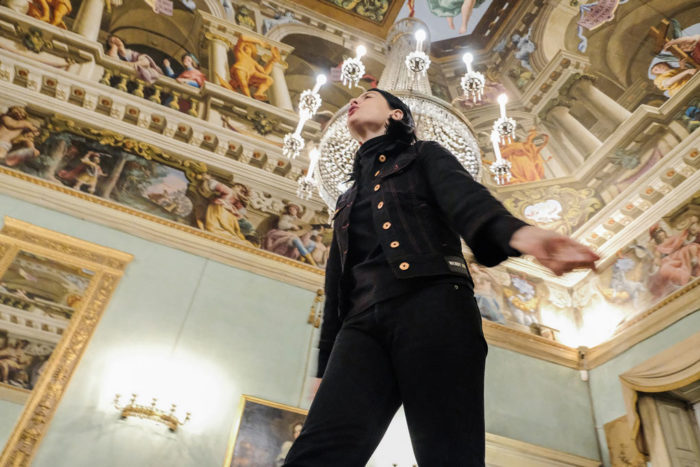
Nora Turato at Palazzo Moroni, The Blank ArtDate. Photo Paolo Biava.
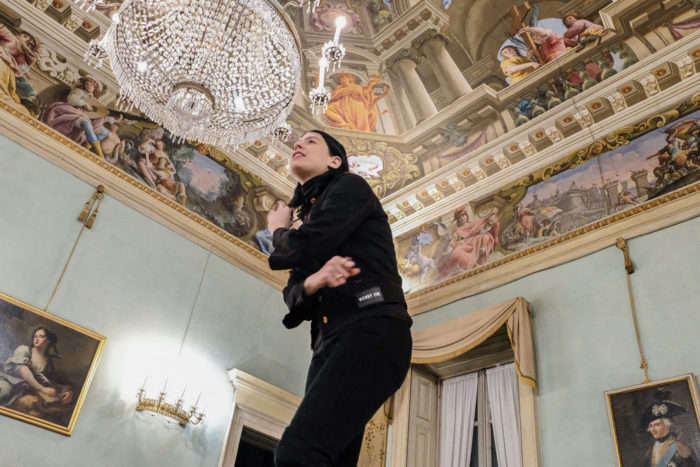
Nora Turato at Palazzo Moroni, The Blank ArtDate. Photo Paolo Biava.
How did the event curated by Maria Marzia Minelli e Claudia Santeroni, for Art Date (organized by The Blank) change its scheme and make Fondazione Museo di Palazzo Moroni resonate? How do the sound, the voice, the spirit of such a performance behave in these ancient buildings and landmarks?
I simply love performing in ancient places. Those moments are special because they make me feel I’ve done something right to deserve my right to inhabit and juxtapose them with myself and my work. I’m always performing my newest script so I think title used in the communication for this event is wrong. I never perform scripts older than 6 months or so. Scripts are always so topical that performing a script a bit too old is always strange and out of place for me. I also love the idea of putting out a body of work that constantly morphs and gets updated in front of the eyes of the audience.
Among accusations, revelations, aggressions, revolutions, inspirations, consumptions, alliteration and reiterations which is the attitude, the improving feature your voice could not ever miss?
I have some years of experience by now. In voice, in speaking, in performing. I’m very proud of this. I think certain things I do now without thinking, would not be possible without all this acknowledged experience.
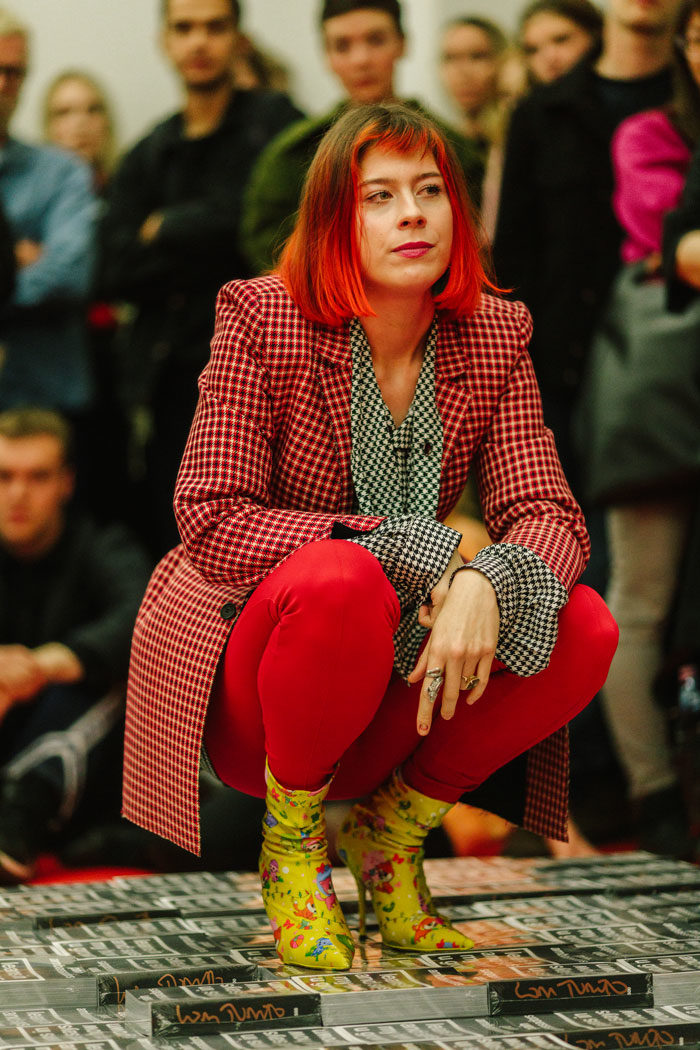
Nora Turato, Pool 2, UKS, Oslo, 2018. Photo Jan Khür. Courtesy the artist and LambdaLambdaLambda.
Could you please share some with us on your future institutional programs for 2020?
Plans for my future? I want to work on my voice, as intensely as one can. just see what can be done with it and where can I possibly take it, in a most formal sense. I would like to write scripts with more specific topics in mind, loosely inspired by late night comedy. I’m curious to take more cues from cinema than I did so far. I have a lot of shows coming up, as from this point, 2020 is looking very crazy. I don’t want to talk about any of those shows, I would rather work on them one by one as they get closer and let one influence another.


